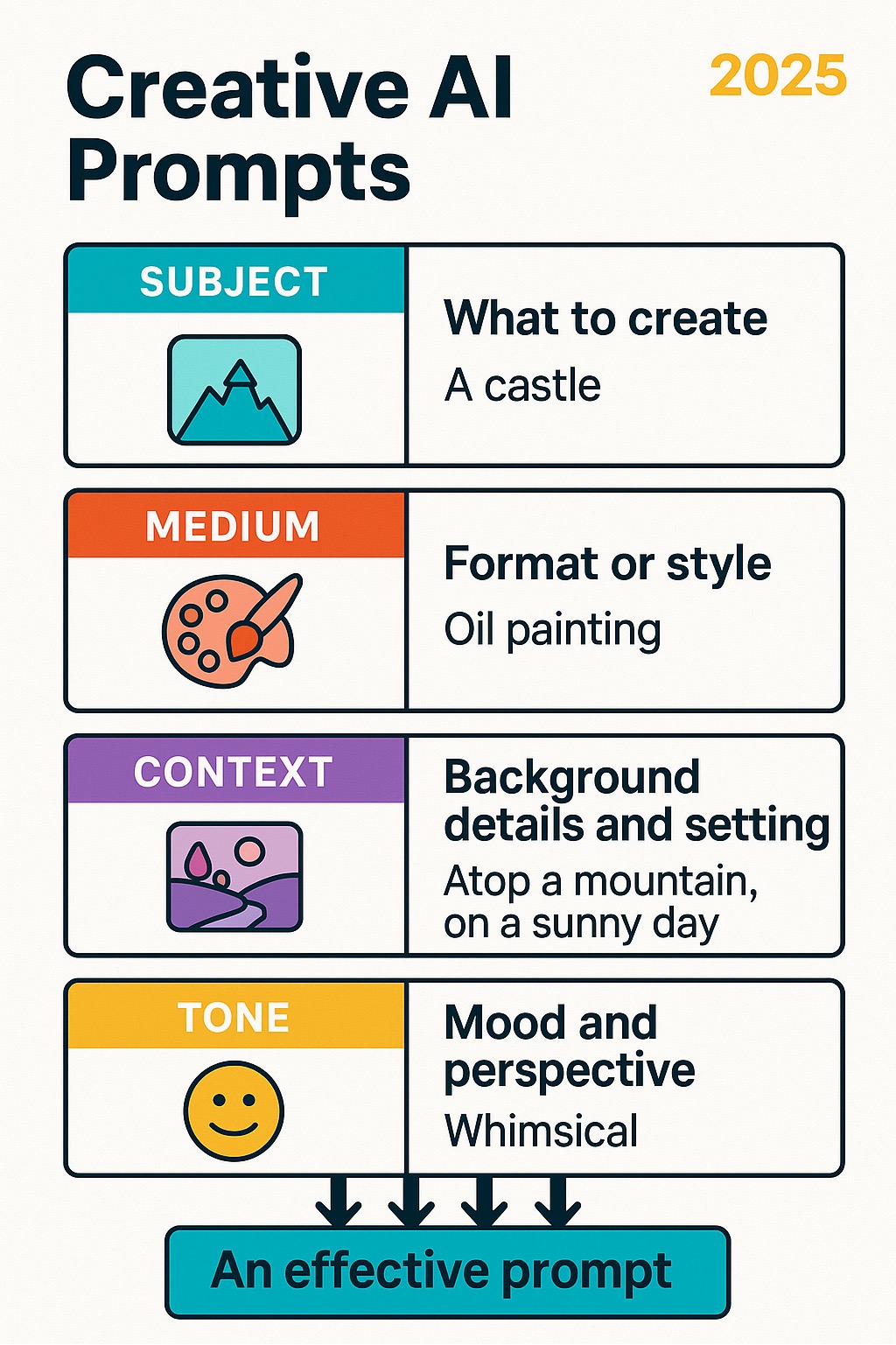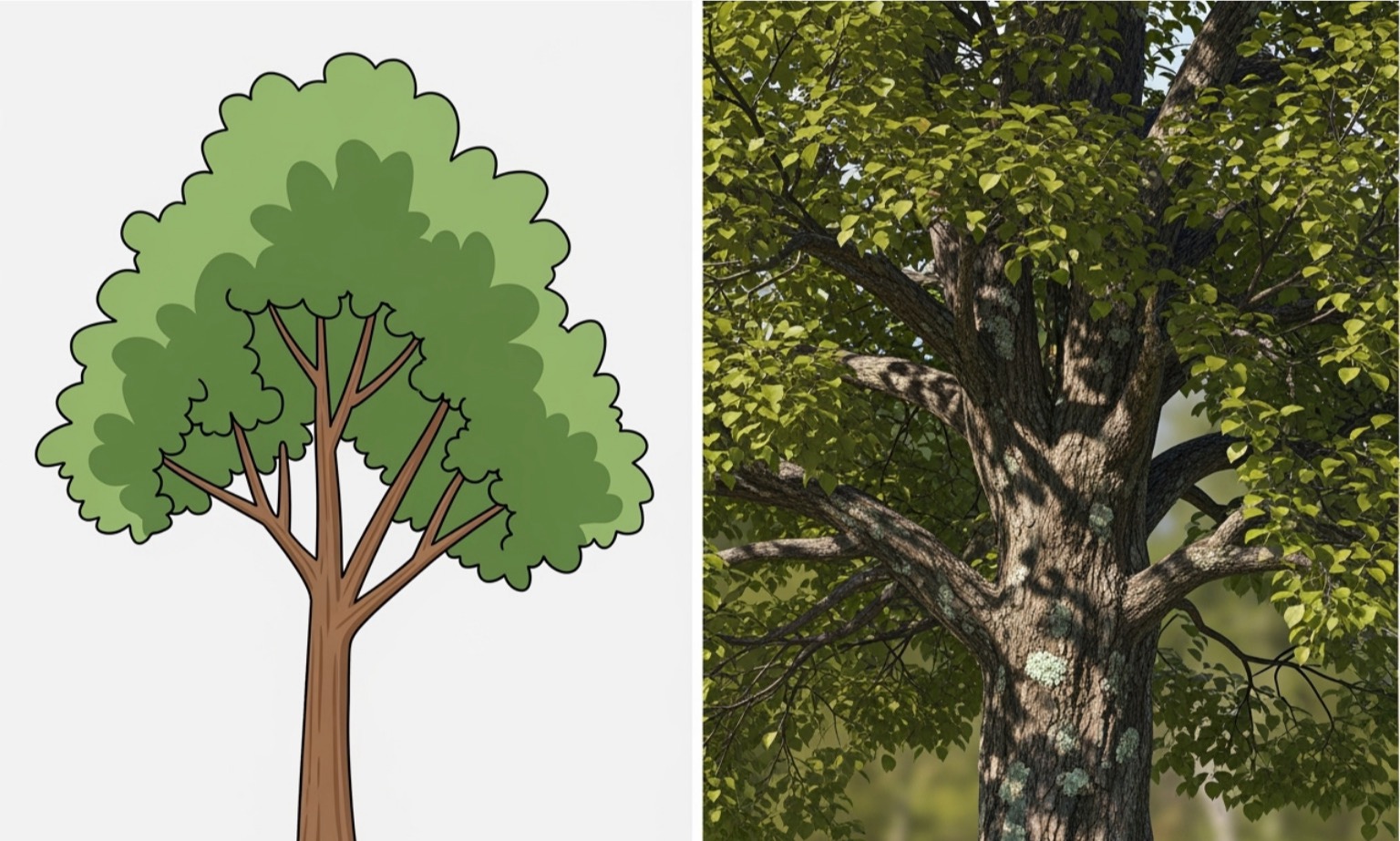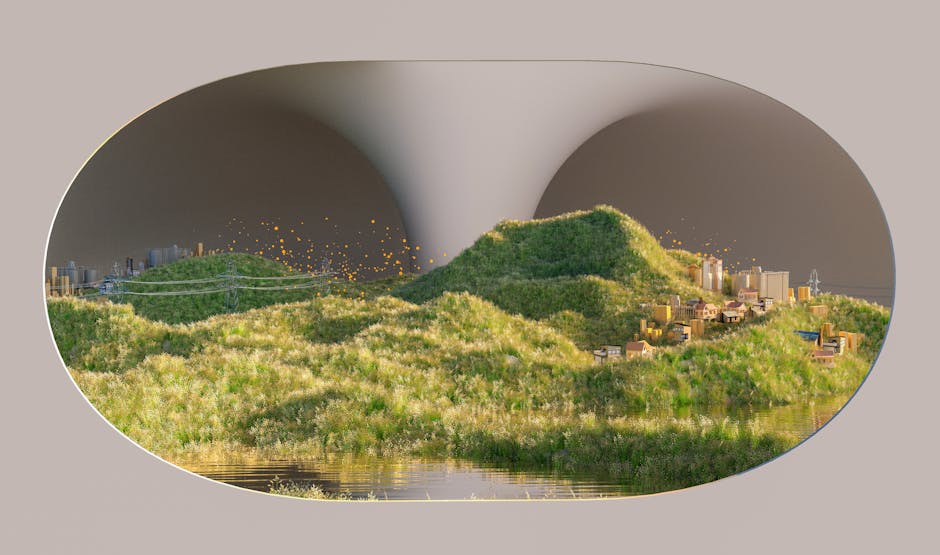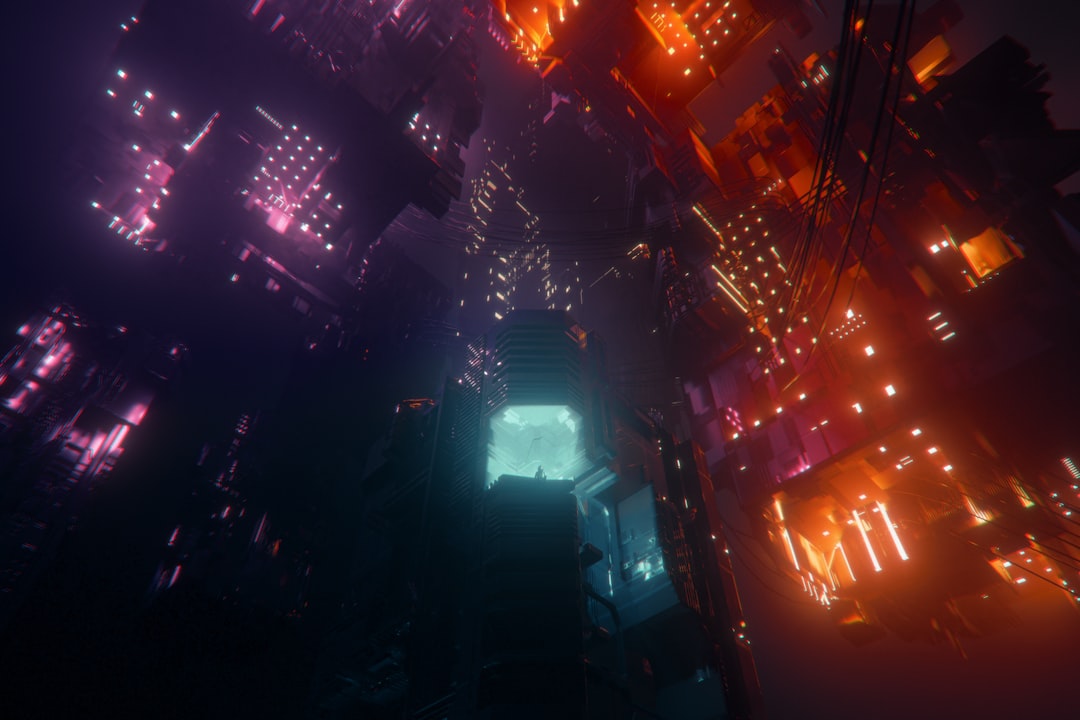Sparking Genius: A Guide to Creative AI Prompt Ideas
Why Creative AI Prompts Are Your Secret Weapon for Breaking Through Creative Blocks

Creative AI prompts are structured instructions that guide AI models to generate original content for writing, art, and more. While most users get stuck with basic requests, the magic happens when you craft detailed prompts that spark unexpected connections. An effective prompt typically includes:
- Subject: What you want to create (a character, a scene).
- Medium: The format or style (an oil painting, a blog post).
- Context: Background details and setting.
- Tone: The desired mood or emotion.
- Constraints: Specific limitations or requirements.
By mastering prompts, you can use AI for story development, visual art generation, marketing copy, and brainstorming. Instead of staring at a blank page, you can use AI as a creative collaborator that never runs out of ideas and approaches problems from angles you might never consider.
Whether you're battling writer's block or need fresh visual concepts, the right prompts transform AI from a simple tool into a creative partner. The key is moving beyond generic requests to craft prompts that are specific enough to guide the AI but open enough to surprise you.

The Anatomy of a Powerful Creative AI Prompt
Think of creative AI prompts as a conversation with a brilliant but literal-minded collaborator. The art of prompt engineering is learning to provide clear directions that open up the AI's creative potential. The magic is in the details.
Instead of asking for "a story," try "a story about a lonely space explorer who finds a sentient nebula, told from the nebula's perspective, in the style of classic sci-fi novels." The second prompt gives the AI rich context, leading to far more interesting results. The goal is to find the sweet spot between specificity and ambiguity—clear enough to guide the AI, but open enough to allow for surprising twists.
Modern AI systems use intent recognition to better understand your requests, analyzing not just words but also context and sentiment. For more detailed guidance, check out this resource on how to write effective prompts for best results.
There are two main approaches: Zero-shot prompts ask the AI to perform a task without examples (e.g., "summarize this article"). Few-shot prompts provide examples first to show the AI what you want.
The Core Building Blocks: Subject, Medium, and Style
Every powerful prompt starts with three essential elements:
- Subject Matter: The "what" of your vision. Be specific. "A golden retriever" is good; "a golden retriever puppy sleeping in a sunbeam" is better.
- Medium: The format you're aiming for. The difference between "an oil painting of a sunset" and "a photograph of a sunset" is dramatic. Options include 3D rendering, charcoal sketch, or papercraft design.
- Style: This taps into the AI's vast knowledge. For art, you can reference movements like Impressionism or specific styles like Risograph printing. For writing, you can request a conversational tone or the style of a detective novel. For visuals, photography terms like "high key lighting" or "bokeh effect" add incredible depth.
- Mood and Tone: These descriptors tie everything together emotionally, whether you want something "serene and peaceful" or "dramatic and intense."
Adding Detail and Nuance: Context, Composition, and Constraints
Once you have your foundation, add layers to make your idea extraordinary.

- Background Information: Set the stage. Tell the AI to "imagine you're an experienced wildlife photographer" or "picture a futuristic city in 2099 where nature has reclaimed the buildings."
- Scene Details: Be descriptive. Instead of "a dog," try "a cream-colored goldendoodle with a blue patch over its left eye." Instead of "Venice Beach," try "Venice Beach during a New Year's Eve fireworks show."
- Composition and Lighting: Direct the AI like a film director. Specify a "bird's eye view" or use lighting like "studio lighting," "volumetric lighting through fog," or "golden hour lighting" to control the mood.
- Color Palettes: Evoke specific feelings with "cool tones," "warm earth tones," or "vibrant jewel tones." For precision, you can reference specific hues from a guide to specific colors.
- Constraints: Limitations often spark creativity. Ask for a summary "under 100 words" or an image "without any people in the frame."
The Power of Persona: Assigning a Role to the AI
Assigning a role or persona to the AI fundamentally changes how it responds. Role-based prompts give the AI a specific lens, changing it from a generator into an expert or character.
- Expert Personas: Ask the AI to act as a "seasoned marketing strategist" for branding work or a "renowned fantasy novelist" for world-building to get specialized insights.
- Creative Personas: Encourage breakthrough thinking by asking the AI to be an "unpredictable writing coach" or a "surrealist painter with a sense of humor." These personas push the AI beyond conventional boundaries.
This technique can even involve "multi-persona self-collaboration," where the AI summons multiple personas to work together on a task, like having a creative team in your pocket.
Crafting Creative AI Prompts for Writing: Beyond "Rewrite"
Writer's block feels like an impossible wall, but creative AI prompts can be the ladder that helps you climb over it. AI can be a creative partner that not only helps overcome blocks but also makes you a better writer by exposing you to new patterns and styles.
However, many users rely on the lazy prompt "rewrite." This gives the AI no real direction, resulting in generic content. Instead, use stronger action words for better results. Try these powerful alternatives:
- Distill: To extract the core message.
- Amplify: To strengthen certain points.
- Reframe: For a fresh perspective.
- Simplify: To make complex ideas accessible.
- Formalize/Informalize: To adjust the tone.
- Expand/Summarize: To change the length and detail.
- Critique: For analysis and feedback.
- Paraphrase: For originality.
For more practical tips, check out How to use AI to do practical stuff.
Formulas for Creative AI Prompts in Storytelling
AI can jump in at any stage of your story development, from character details to plot holes.
- Character Development: Ask AI to dig into backstories and motivations. Prompt Example: "Create a detailed backstory for a former teacher who became a private investigator, focusing on her trust issues and determination."
- Plot Generation: When you're stumped, ask for complications or twists. Prompt Example: "Outline a mystery where a librarian finds that banned books are disappearing from reality, including three major revelations."
- World-Building: AI can help create entire universes with consistent rules. Prompt Example: "Describe a society where emotions are visible as colored auras, detailing how this affects relationships and social hierarchies."
- Dialogue Writing: AI can capture different voices and speech patterns. Prompt Example: "Write a conversation between a cynical teenager and their optimistic guidance counselor about college plans."
- Metaphor and Analogy Creation: Good metaphors help readers understand complex ideas. AI can generate powerful connections. To learn more, explore Use AI to Create Powerful Metaphors in Your Writing.
Prompts for Unconventional and Thought-Provoking Content
Push AI beyond conventional thinking to find creative breakthroughs. Ask it to generate counterintuitive insights to shake up tired topics ("What surprising truths about productivity would most people not know?"). Use it to create provocative questions that make readers think, or to find surprising historical examples to illustrate your points.
One of AI's most valuable roles is identifying blindspots in our thinking. Ask it to play devil's advocate or examine your ideas from different cultural perspectives. Be explicit about wanting bold ideas by telling the AI to "be surprising" or "suggest something unconventional." When you give it permission to be weird, the most interesting ideas often emerge.
Opening up Visual Masterpieces: Creative AI Prompts for Art
Imagine describing a scene in words and watching a stunning piece of art materialize in seconds. That's the magic of today’s text-to-image generation tools. The time savings are remarkable, but what's truly exciting is how these systems help overcome artistic block by providing endless inspiration.

AI art is rapidly evolving, and mastering the right vocabulary in your creative AI prompts is key to opening up its full potential.
How Styles, Mediums, and Elements Shape AI Art
Think of these elements as your artistic vocabulary—the more precise your language, the more stunning your results.
- Art Movements & Styles: Mentioning "Dutch Master oil painting" or "Pop Art" taps into centuries of artistic tradition. Modern digital art styles like "cartoon art" or "surreal digital illustration" guide the AI toward contemporary aesthetics.
- Photography & Lighting: Terms like "cinematic lighting" or "bokeh photograph" add professional depth. The choice between "natural lighting" and "volumetric lighting" can completely transform the mood, while "neon lighting" creates a cyberpunk feel and "golden hour" adds warmth.
- Color & Texture: Color theory controls the emotional impact. Use "cool tones" for calm, "warm tones" for comfort, or "vibrant" colors for energy. A fun trick is using material textures; asking for subjects "made of porcelain," "made of light," or "made of bubbles" can create stunning effects.
For more on AI tools for creators, you can explore services like ours at Potions.
Example Creative AI Prompts for Different Aesthetics
The secret to compelling AI art is being specific about mood, color, subject, lighting, and perspective.

- Photorealism: "A hyperrealistic portrait of an elderly woman with kind eyes, wrinkles showing wisdom, natural light, shallow depth of field."
- Surrealism: "A city where buildings twist like wax under a neon moon, with oversized, luminescent cats lounging on floating clouds, Salvador Dali style."
- Cyberpunk: "A futuristic cityscape at night, with neon lights reflecting on wet streets and holographic advertisements, highly detailed."
- Fantasy: "An ancient elven village nestled within colossal bioluminescent trees, with mystical creatures gathering under a moonlit sky, epic fantasy art."
- Abstract: "A vibrant explosion of colors representing the sound of laughter, with interconnected lines evoking chaos merging into harmony, expressive abstract painting."
Experiment by combining different mediums (oil painting, pixel art), materials (made of glass, made of chrome), photography styles (macro, film noir), lighting (rim light, moonlight), colors (pastel, monochrome), and art movements (Impressionism, Art Deco). The magic happens when you iterate and find unexpected combinations.
The Art of Iteration: Evolving Your Prompts for Genius Results
Prompt engineering is like learning to paint; the first attempt is rarely perfect. The magic of creative AI prompts happens through iterative refinement. Instead of starting over when a result isn't quite right, build on it conversationally: "that's good, but make it more mysterious" or "perfect, now add a steampunk aesthetic." This back-and-forth between human creativity and AI capability is where breakthroughs emerge.
While some argue that AI prompt engineering isn't the future, mastering iteration is currently what separates good results from great ones. This is why version control for prompts is so powerful. Imagine never losing a great prompt variation. You can experiment freely, knowing you can always return to what worked. It transforms prompt crafting from a fleeting moment into a structured, evolving creative process.
Advanced Techniques: Weighting, Negative Prompts, and Chaining
These advanced techniques offer more precise control over your prompts:
- Keyword Weighting: Emphasize what matters most. In some models, you can write "A majestic cat ::2 sitting on a simple mat ::0.5" to make the cat twice as important as the mat.
- Negative Prompts: Exclude unwanted elements. Adding "no extra limbs, no distorted hands" helps the AI avoid common visual errors.
- Chaining Prompts: Create complex, multi-stage workflows. Generate a character description, feed it into a scene prompt, and then use both to create dialogue. Each step builds on the last.
- Unexpected Juxtapositions: Combine concepts that don't normally go together, like "a spaceship made of coral growing through an abandoned library." This pushes the AI into truly original territory.
From Solo Skill to Collaborative Craft
The most innovative creative AI prompts often emerge from community collaboration. Sharing prompts has become second nature in creative communities, creating a rising tide that lifts everyone's work. It's like open-source software, but for creativity.
Learning from the community accelerates your growth, while remixing existing prompts helps you develop a personal style. The vision is to build a knowledge library where every breakthrough is preserved and shared. This open source ethos transforms creativity from a solitary struggle into a collaborative journey.
This is exactly what we're building at Potions—a place where prompt engineering evolves into a collective craft. Your creative breakthroughs become stepping stones for others, and the world's best prompts are just a search away.
Navigating the Landscape: Challenges and Ethics in AI Creation
Creative AI prompts are powerful but not perfect. It's crucial to understand their challenges to use them thoughtfully. One major issue is "AI hallucination," where an AI confidently generates content that is completely wrong or made up. Always fact-check important outputs and think of AI as a brainstorming partner, not an encyclopedia. For a deeper dive, see this article on When AI chatbots hallucinate.
Responsible AI use means recognizing that AI is a tool that amplifies our creativity, not a replacement for human judgment. The final creative decisions and ethical considerations are still on us.
Addressing AI Bias and Ensuring Inclusivity
AI models learn from the internet, which unfortunately reflects humanity's biases. This means AI can perpetuate racial blind spots, gender stereotypes, and other inherent model biases. For example, an MIT student asked an AI to make her headshot more "professional," and it returned an image with lighter skin and blue eyes, revealing a deeply embedded bias. You can read about it here: An MIT student asked AI to make her headshot more professional. It gave her lighter skin, blue eyes.
To combat this, practice diverse prompting by specifying different ethnicities, genders, and backgrounds. Use negative prompts to exclude stereotypes (e.g., "avoiding gender bias"). Always critically review AI outputs and regenerate anything that feels biased with a more inclusive prompt.
Copyright, Authorship, and Fair Use
The legal landscape around AI-generated content is still evolving. Key issues include:
- Using Artist Names: Using living artists' names in prompts is ethically murky, as it can be seen as exploiting their style without compensation. It's often better to describe a style rather than name a specific living creator.
- Copyright: Who owns AI-generated art? The laws vary by country and are still catching up to the technology.
- Training Data: Most models were trained on vast amounts of online content, often without the original creators' permission, raising questions about fair use and artistic rights.
- Originality: The debate continues on whether AI work is truly original, which affects how we define authorship and value creativity in an AI-powered world.
Staying informed and being ethical in our AI use is key as the creative community steers these challenges.
Frequently Asked Questions about Creative AI Prompts
What makes a good creative AI prompt?
A good prompt blends specificity with creative freedom. It clearly defines the subject, medium, and style, but also includes rich details, context, and mood. Assigning a persona to the AI ("act as a cynical art critic") and using strong action verbs ("distill," "amplify") instead of generic ones ("rewrite") also leads to much better results.
How can I avoid generic or predictable AI-generated content?
To break free from bland outputs, push the AI into uncharted territory. Use unconventional adjectives and combine concepts that don't normally go together (e.g., "a melancholic sunset that tastes like forgotten memories"). Ask the AI to adopt unusual perspectives, like writing from the viewpoint of an inanimate object. Iterate on the AI's first response, asking for something "more surprising" or "counterintuitive."
Is using AI for creative work considered cheating?
No. Most creators view AI as a collaborative partner, not a shortcut. It's a sophisticated tool, like Photoshop for a photographer or a synthesizer for a musician. Human creativity remains at the center—you make the key decisions, provide the vision, and curate the results. AI doesn't replace your artistic judgment; it amplifies your ability to explore ideas and overcome creative blocks.
Conclusion
We've journeyed through creative AI prompts, seeing how they've evolved from simple instructions into a powerful bridge between human imagination and artificial intelligence. You now know that crafting effective prompts is a skill—one that combines clear subjects and mediums with rich context and assigned personas to produce creative gold.
This skill is reshaping creative work. But what's most exciting is that AI isn't replacing human creativity; it's amplifying it. The AI is your collaborator, but you remain the director, the curator, and the visionary. While we must steer the real challenges of bias and ethics, the future of AI-assisted creation is incredibly bright.
This future of collaborative creation is moving from a solo struggle to a shared craft, where creators can build on each other's work, remix proven prompts, and contribute to a growing knowledge base. This is the world we're building at Potions.
We've created a platform where your creative experiments are automatically saved and versioned, where you can find prompts that have already solved problems like yours, and where your innovations can inspire others. It's prompt engineering with a safety net and a community behind you.
Ready to see what's possible when thousands of creative minds collaborate? Come Explore the world's best prompts and join us in changing how the world creates with AI. Your next breakthrough might be just one remix away.